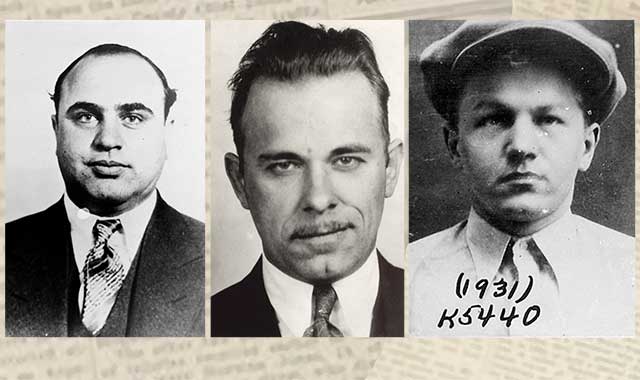
Al Capone's Beer Wars
A Complete History of
Organized Crime in Chicago
During Prohibition
John J. Binder
(Prometheus Books)

This is a four-hundred page study of Chicago during Prohibition. It is filled with charts and photographs. The first chart runs for four pages, shows gambling and vice arrests in Chicago between 1875 and 1973, along with something called the "Vice Index," the number of offenses committed per capita as a function of arrests.On the other hand, table six shows "Method of Killing - - - for all killings, for members of major bootlegging gangs, by cause of death:
The horizontal column includes:
- shotgun
- machine gun
- stabbing
- strangulation
- explosion
- beating
and ends with "one way ride" (which apparently peaked in 1925).
- bootlegging
- unione siciliana
- gambling
- labor union
- rackets
- business rackets
- taxi cab wars
- vice/tong wars
§ § § It's a fairly sordid business, and the photographs add to the sense of unreality. Portraits include such characters as
- Jack McGuin (serious)
- Daniel McGeoghegan (chinless)
- Aphonse Capone (white fedora, smiling)
- Nick Circella (white fedora, strained smile)
- "Sonny" Capone (young, grinning, running)
- Tony Lombardo (black fedora, sullen)
- Steve Sumner (older, stentorious)
- John Torrio (tense, bow-tie)
- Dominic Roberto (chipper, smiling)
- "Three-Fingered" Jack (hands not shown)
- Frank Foster (tie, suit, bored)
- "Gloomy Gus" Schaefer (gloomy)
- Cornelius "Con" Shea (sneering)
- Tommy Touhy (dark, nervous)
- "Spike" O'Donnell (intent, cigar in mouth)
- "Tough Tony" Capezio (tough, tony)
- Tony Genna (bloody, shot)
- "Dingbat" O'Berta (bloody, deceased)
- Lorenzo Juliano (passed on, bloodless).
Other names of interest include "Patsy" King, John V. "Mushmouth" Johnson, Maurice "Mossy" Enright, Michael J. "Umbrella Mike" Boyle, John "Bathhouse" Coughlin, Joey "The Clown" Lombardo, George "Bugs" Moran, Samuel "Nails" Morton, and in an interesting reversal, William "Dutch" Gentleman who was, presumably, no gentleman.
Several Ladies of the Night are also included: Iva Pink Carroll, Mable Devo, and Mador Marat, this last presumably distantly related to the Jean-Paul Marat of the French loony-bin Charenton.
If any place was destined to detest Prohibition, Chicago was it. According to Binder, in 1906, Chicago sported 7300 saloons and "probably 1000 "blind pigs" (unlicensed bars) but how did they know how many pigs, not to say blind ones, were in existence? Ultimately, in 1919, Chicago voted three to one against a local ordinance closing the saloons, but in the end the eighteenth amendment usurped this timely vote of conscience.
Al Capone's Beer Wars isn't much fun and, although the whole prohibition duke-it-out scene could be dramatic if not deadly, this volume is best for people who are looking for their Chicago dry, stirred not shaken. Many of the poor-quality shots of the massacres are fairly repulsive. Blood, as would be expected, comes out black if grisly in these overdeveloped b&w photos.
After awhile, this reader finds herself begging for anything more than the endless name-dropping and statistics. At least, we ought to give the writer points for his singular take on how one should view the all-over waste and carnage.
For John "Judgment" Binder is a professor - - - presumably a professor of Boozology or Ganglia - - - at the University of Illinois in Chicago. Being a professor, he seems most comfortable handing out grades to the top gangsters of the era. "Big Jim" Colosimo gets a B+ because he was there the firstest with the mostest. John Torrio receives an A- as "a superb strategist and excellent leader," but was "deficient as a warlord" because he "lacked fortitude." A photograph showing him defunct might give the professor some second thoughts about his grading system.
Extra credit is extended to the Chicago Heights gangsters who pioneered "an odorless method of distilling that avoided detection and was copied by others" (although we can thus assume it was not granted a patent at the United States Patent and Trademark Office. Some of us still in our teens would've been quick to pay an extra buck or so for "Scentless" scotch or "Stink-Free" rock-gut).
"Other innovations were less dramatic and were more about seeing the angles and exploiting them, at which Capone and his men were experts."
For example, if Jewish congregations in New York were not using all the sacramental wine they were allowed under the law, the Capone gang was happy to buy the federal permits from the rabbis and redirect the win to other locations.
Al Capone thus gets an A- for "his business sense and excellent martial skills" but might well have been downgraded by Binder for getting popped and shipped off to the U. S. Penitentiary in Atlanta in 1932. Still, he might have been awarded extra points because of being so innovative.
Although they were not the first to use the Thompson submarine gun, they quickly adopted it and introduced the machine gun nest to gangland in the killing of Hymie Weiss.
It is not stated, but we would suppose that Hymie flunked out not for lack of business sense but, worse, not knowing when to lay low.
--- Pamela Wylie